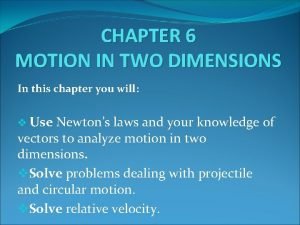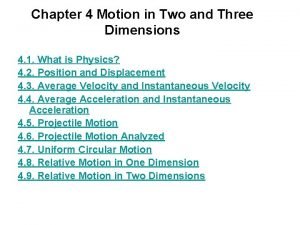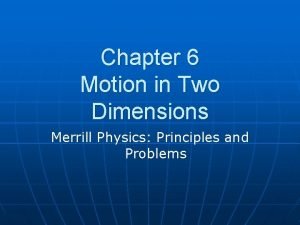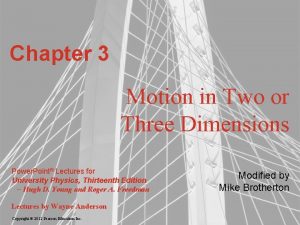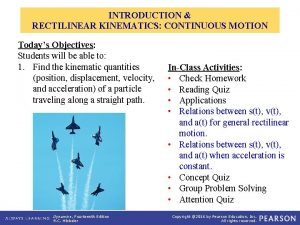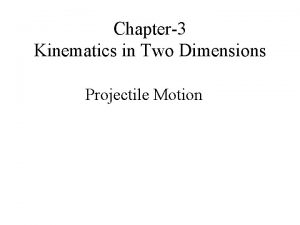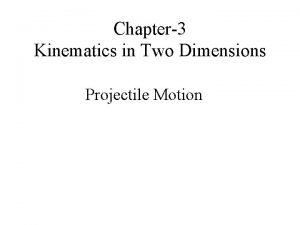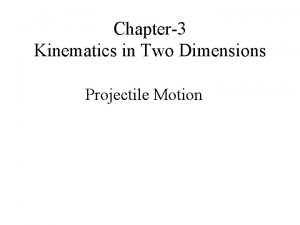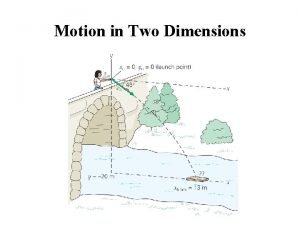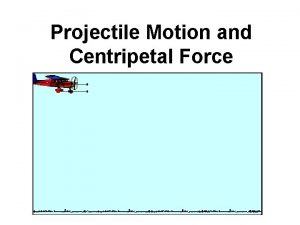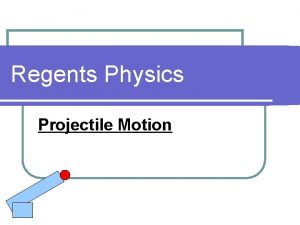Kinematics in Two Dimensions Projectile Motion A projectile













- Slides: 13

Kinematics in Two Dimensions

Projectile Motion A projectile is an object moving in two dimensions under the influence of Earth's gravity; its path is a parabola.

Projectile Motion It can be understood by analyzing the horizontal and vertical motions separately.

Projectile Motion The speed in the x-direction is constant; in the ydirection the object moves with constant acceleration g. This photograph shows two balls that start to fall at the same time. The on the right has an initial speed in the x-direction. It can be seen that vertical positions of the two balls are identical at identical times, while the horizontal position of the yellow ball increases linearly.

Projectile Motion If an object is launched at an initial angle of θ 0 with the horizontal, the analysis is similar except that the initial velocity has a vertical component.

Solving Problems Involving Projectile Motion Projectile motion is motion in two dimensions, with constant acceleration, where the acceleration is g and is down.

Solving Problems Involving Projectile Motion 1. Read the problem carefully, and choose the object(s) you are going to analyze. 2. Draw a diagram. 3. Choose an origin and a coordinate system. 4. Decide on the time interval; this is the same in both directions, and includes only the time the object is moving with constant acceleration g. 5. Examine the x and y motions separately.

Solving Problems Involving Projectile Motion 6. List known and unknown quantities. Remember that vx never changes, and that vy = 0 at the highest point. 7. Plan how you will proceed. Use the appropriate equations; you may have to combine some of them.

Relative Velocity We already considered relative speed in one dimension; it is similar in two dimensions except that we must add and subtract velocities as vectors. Each velocity is labeled first with the object, and second with the reference frame in which it has this velocity. Therefore, v. WS is the velocity of the water in the shore frame, v. BS is the velocity of the boat in the shore frame, and v. BW is the velocity of the boat in the water frame.

A variation on the monkey and the hunter

Range of a Projectile

Example 3– 9: the football leaves the punter’s foot at y = 0, and reaches the ground where y = -1. 00 m.

Relative Velocity In this case, the relationship between the three velocities is:
 Formula for time of flight in projectile motion
Formula for time of flight in projectile motion Aplusphysics kinematics-horizontal kinematics
Aplusphysics kinematics-horizontal kinematics Chapter 6 study guide motion in two dimensions
Chapter 6 study guide motion in two dimensions Rafi is pulling a toy wagon
Rafi is pulling a toy wagon Chapter 6 motion in two dimensions
Chapter 6 motion in two dimensions Motion in two and three dimensions
Motion in two and three dimensions Chapter 6 motion in two dimensions
Chapter 6 motion in two dimensions Motion in two and three dimensions
Motion in two and three dimensions Vectors quick check
Vectors quick check Quickchek menu
Quickchek menu Does weight affect projectile motion
Does weight affect projectile motion A projectile has a single force that acts upon it
A projectile has a single force that acts upon it Rectilinear kinematics
Rectilinear kinematics Rectilinear kinematics
Rectilinear kinematics




